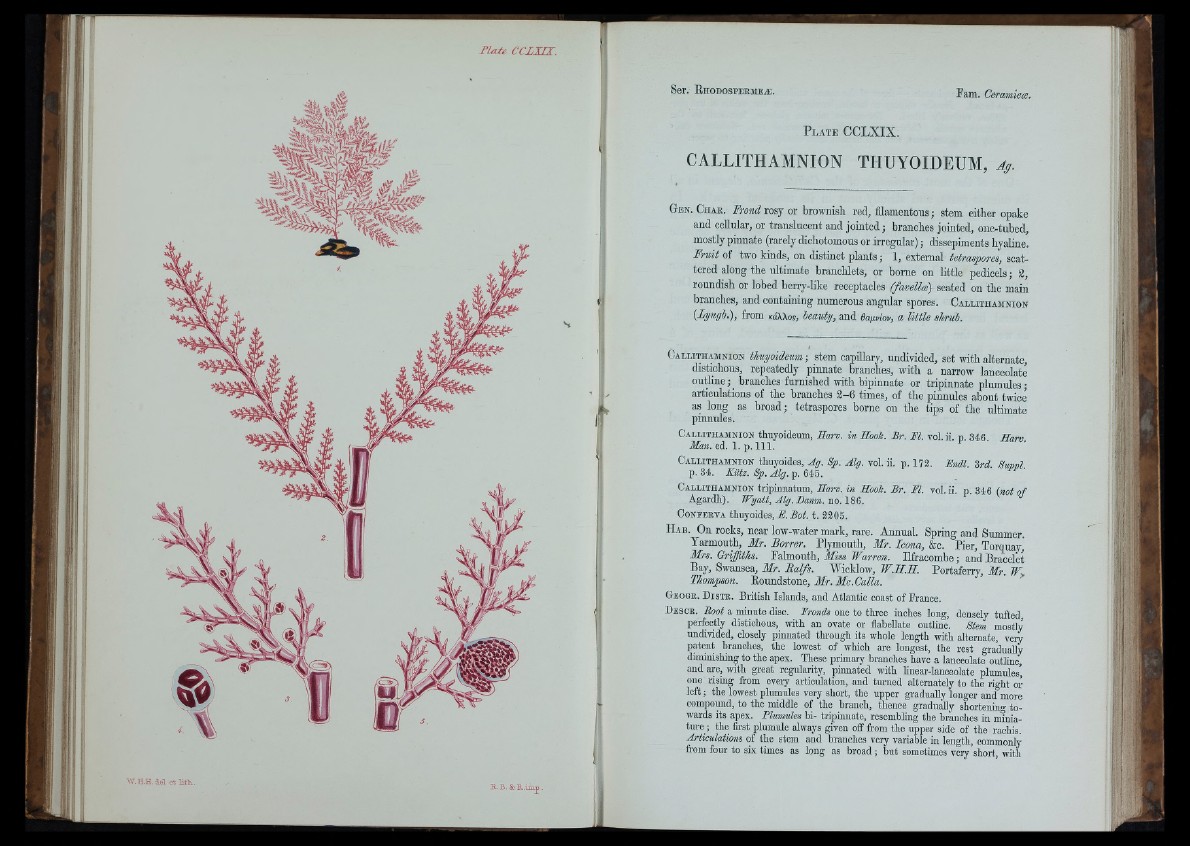
P l a t e CCLXIX.
CALLITHAMNION THUYOIDLUM, Ag.
G e n . Ch a r . Frond rosy or brownish red, filamentous; stem either opake
and cellular, or translucent and jointed ; branches jointed, one-tubed,
mostly pinnate (rarely dichotomous or irregular) ; dissepiments hyahne.
F ru it of two kinds, on distinct plants ; 1, external tetraspores, scattered
along the ultimate branchlets, or borne on little pedicels ; 2,
roundish or lobed berry-like receptacles (fa v e lla ) seated on the Tnnrô
branches, and containing numerous angular spores. Ca llithamnion
(L y n g h ), from kúXKos, heauty,aT\A Sagviov, a little shrub.
'i Callithamnion thuyoideum ; stem capfllary, undivided, set with alternate,
distichous, repeatedly pinnate branches, with a narrow lanceolate
outline ; branches furnished with bipiunate or tripinnate plumules ;
articulations of the branches 2 -6 times, of the pinnules about twice
as long as broad; tetraspores borne on the tips of the ultimate
pinnules.
C a l l i t h a m n i o n th u y o id e um , Harv. in Hook. Br. FI. v o l. ii. p. 3 4 6 . Harv
Man. e d . 1 . p . 1 1 1 .
C a l l it h a m n io n th u y o id e s , Ag. Sp. Alg. v o l. ii. p . 1 7 3 . Midi. Zrd. Suppl
p. 3 4 . Kütz. Sp. Alg. p. 6 4 5 .
C a l l i t h a m n i o n t r ip m n a tu m , Harv. in Hook. Br. M. v o l .i i . p. 3 4 6 (not of
A g a r d li ) . Wyatt, Alg. Banm. n o . 1 8 6 .
C o n f e r v a th u y o id e s , Æ. .Bof. t . 3 3 0 5 .
H a b . On rooks, near low-water mark, rare. Annual. Spring and Summer.
Yarmouth, M r. Borrer. Plymouth, Mr. Icona, Sic. Pier, Torquay!
Mrs. Griffiths. Palmouth, Miss Warren. Ilfracombe ; and Bracelet
Bay, Swansea, Mr. R a lfs. Wicklow, W .H .H . Portaferry, Mr.
Eoundstone, J fr.
G e o g e . D i s t e . British Islands, and Atlantic coast of France.
D e s c e . Boot a minute disc. Fronds one to three inches long, densely tufted,
perfectly distichous, with an ovate or flabellate outline. Stem mostly
undivided, closely pinnated thi'ough its whole length with alternate, veiy
patent branches, the lowest of which are longest, the rest gradually
diminishing to the apex. These primary branches have a lanceolate outline,
and are, with great regularity, pinnated with linear-lanceolate plumules’,
one rising from every articulation, and turned alternately to the right or
left ; the lowest plumules very short, the upper gradually longer and more
compound, to the middle of the branch, thence gradually shortening towards
its apex. Plumules bi- tripinnate, resembUng the branches in miniature
; the first plumule always given off from the upper side of the rachis.
Articulations of the stem and branches very variable in length, commonly
from four to six times as long as broad ; but sometimes very short, with